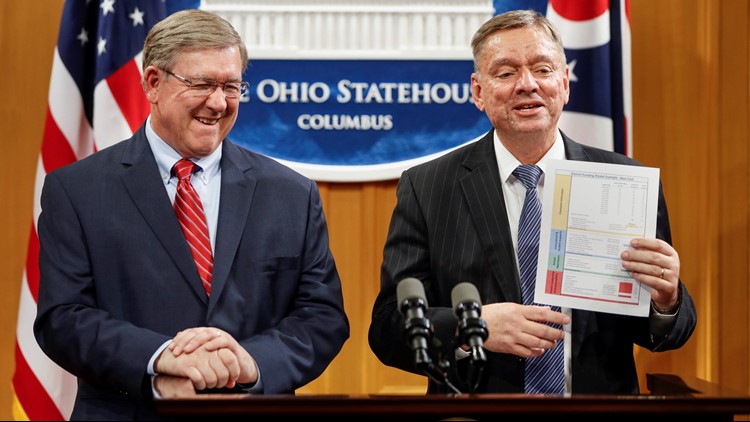COLUMBUS, Ohio (AP) — State lawmakers proposing an overhaul of how Ohio funds schools said Monday that it would more fairly split local and state shares and factor in the cost of educating a child and a community's ability to help pay for it.
But they weren't yet willing to reveal the overall higher price tag, instead focusing on the system they want to phase in over several years.
"Our plan treats all Ohio school districts and taxpayers fairly, based on their ability to pay," said Democratic Rep. John Patterson, a former teacher from Jefferson who, with Republican Rep. Bob Cupp, of Lima, led a workgroup of public-school officials for more than a year to come up with the plan.
Ohio's funding system has been repeatedly adjusted since the state Supreme Court found it unconstitutional 22 years ago in the landmark lawsuit DeRolph v. State.
Schools currently get a mix of federal funding, local sources such as taxes, and state disbursements that vary depending on enrollment and property values. Advocates argue fairer funding is needed to untangle that complicated patchwork and help address an achievement gap that correlates to poverty.
Cupp said he believes the proposed overhaul would be constitutional.
A "base cost" for educating children would be determined for each of Ohio's 600-plus school districts, including expenses such as teacher salaries, basic social and emotional support, and providing a laptop or other technological device for each student. Additional funding would be provided for other needs, such as students in poverty, career technical education, and preschool access for economically disadvantaged 4-year-olds.
The expected local share of K-12 funding for each district would take into account property values as well as income levels. The workgroup said that would create a more stable, predictable way to determine the local share.
Funding for charter schools would be direct, no longer flowing through local districts. And the plan would end a system of caps on funding for districts gaining students.
Public-school advocates and teachers unions praised the proposal as an overdue step in the right direction.
Bill Phillis, whose Ohio Coalition for Equity & Adequacy of School Funding helped bring the DeRolph case, said the proposal would fund education the right way, "on the basis of cost." He said Ohio has spent too long doing the opposite — allocating money, then figuring out how much education it would buy.
He said there seems to be growing will in state government to address school-funding issues, but noted that the full cost hasn't yet been shared as lawmakers begin considering the proposal.
Cupp and Patterson said they believe the state would have enough revenue to fund their plan.
"The question is will," Patterson said. "Do we have the will to fund what we really need to fund if we truly believe that every student has a chance to succeed and ought to have that chance to succeed for the future?"
A statement from Republican House Speaker Larry Householder said he looks forward to the process and "making any changes necessary to make the proposal better."
House Minority Leader Emilia Strong Sykes, D-Akron, said in a statement that the broken funding system "held back too many Ohio children for over a generation" and she supports efforts to fix it.
GOP Gov. Mike DeWine has said children are a priority for him, too. He proposed allotting $550 million in new funding in the two-year state budget to help schools support and encourage students through after-school programs, mentoring, mental health counseling and other "wraparound" services, and targeting much of that funding toward higher-poverty areas. DeWine said he didn't include further changes to school funding because the Legislature would be working on that.



